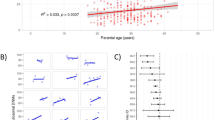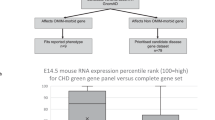Abstract
Emerging evidence suggests that children conceived through assisted reproductive technology (ART) have a higher risk of congenital heart defects (CHDs) even when there is no family history. De novo mutation (DNM) is a well-known cause of sporadic congenital diseases; however, whether ART procedures increase the number of germline DNM (gDNM) has not yet been well studied. Here, we performed whole-genome sequencing of 1137 individuals from 160 families conceived through ART and 205 families conceived spontaneously. Children conceived via ART carried 4.59 more gDNMs than children conceived spontaneously, including 3.32 paternal and 1.26 maternal DNMs, after correcting for parental age at conception, cigarette smoking, alcohol drinking, and exercise behaviors. Paternal DNMs in offspring conceived via ART are characterized by C>T substitutions at CpG sites, which potentially affect protein-coding genes and are significantly associated with the increased risk of CHD. In addition, the accumulation of non-coding functional mutations was independently associated with CHD and 87.9% of the mutations were originated from the father. Among ART offspring, infertility of the father was associated with elevated paternal DNMs; usage of both recombinant and urinary follicle-stimulating hormone and high-dosage human chorionic gonadotropin trigger was associated with an increase of maternal DNMs. In sum, the increased gDNMs in offspring conceived by ART were primarily originated from fathers, indicating that ART itself may not be a major reason for the accumulation of gDNMs. Our findings emphasize the importance of evaluating the germline status of the fathers in families with the use of ART.
Similar content being viewed by others
Log in or create a free account to read this content
Gain free access to this article, as well as selected content from this journal and more on nature.com
or
References
Kushnir, V. A., Barad, D. H., Albertini, D. F., Darmon, S. K. & Gleicher, N. Systematic review of worldwide trends in assisted reproductive technology 2004-2013. Reprod. Biol. Endocrinol. 15, 6 (2017).
Yang, X., Li, Y., Li, C. & Zhang, W. Current overview of pregnancy complications and live-birth outcome of assisted reproductive technology in mainland China. Fertil. Steril. 101, 385–391 (2014).
Hansen, M., Kurinczuk, J. J., Milne, E., de Klerk, N. & Bower, C. Assisted reproductive technology and birth defects: a systematic review and meta-analysis. Hum. Reprod. Update 19, 330–353 (2013).
Romundstad, L. B. et al. Effects of technology or maternal factors on perinatal outcome after assisted fertilisation: a population-based cohort study. Lancet 372, 737–743 (2008).
Niakan, K. K., Han, J., Pedersen, R. A., Simon, C. & Pera, R. A. Human pre-implantation embryo development. Development 139, 829–841 (2012).
Declercq, E. et al. Perinatal outcomes associated with assisted reproductive technology: the Massachusetts Outcomes Study of Assisted Reproductive Technologies (MOSART). Fertil. Steril. 103, 888–895 (2015).
Boulet, S. L. et al. Assisted reproductive technology and birth defects among liveborn infants in Florida, Massachusetts, and Michigan, 2000-2010. JAMA Pediatr. 170, e154934 (2016).
Goldmann, J. M., Veltman, J. A. & Gilissen, C. De novo mutations reflect development and aging of the human germline. Trends Genet. 35, 828–839 (2019).
Sasani, T. A. et al. Large, three-generation human families reveal post-zygotic mosaicism and variability in germline mutation accumulation. Elife 8, e46922 (2019).
Deciphering Developmental Disorders Study. Prevalence and architecture of de novo mutations in developmental disorders. Nature 542, 433–438 (2017).
Iossifov, I. et al. The contribution of de novo coding mutations to autism spectrum disorder. Nature 515, 216–221 (2014).
Epi, K. C. et al. De novo mutations in epileptic encephalopathies. Nature 501, 217–221 (2013).
Short, P. J. et al. De novo mutations in regulatory elements in neurodevelopmental disorders. Nature 555, 611–616 (2018).
de Ligt, J. et al. Diagnostic exome sequencing in persons with severe intellectual disability. N. Engl. J. Med. 367, 1921–1929 (2012).
Homsy, J. et al. De novo mutations in congenital heart disease with neurodevelopmental and other congenital anomalies. Science 350, 1262–1266 (2015).
Zaidi, S. et al. De novo mutations in histone-modifying genes in congenital heart disease. Nature 498, 220–223 (2013).
Sifrim, A. et al. Distinct genetic architectures for syndromic and nonsyndromic congenital heart defects identified by exome sequencing. Nat. Genet. 48, 1060–1065 (2016).
Jin, S. C. et al. Contribution of rare inherited and de novo variants in 2,871 congenital heart disease probands. Nat. Genet. 49, 1593–1601 (2017).
Menken, J., Trussell, J. & Larsen, U. Age and infertility. Science 233, 1389–1394 (1986).
Goldmann, J. M. et al. Germline de novo mutation clusters arise during oocyte aging in genomic regions with high double-strand-break incidence. Nat. Genet. 50, 487–492 (2018).
Jonsson, H. et al. Parental influence on human germline de novo mutations in 1,548 trios from Iceland. Nature 549, 519–522 (2017).
Goldmann, J. M. et al. Parent-of-origin-specific signatures of de novo mutations. Nat. Genet. 48, 935–939 (2016).
Kong, A. et al. Rate of de novo mutations and the importance of father’s age to disease risk. Nature 488, 471–475 (2012).
Bergh, C., Pinborg, A. & Wennerholm, U. B. Parental age and child outcomes. Fertil. Steril. 111, 1036–1046 (2019).
Carlson, J. et al. Extremely rare variants reveal patterns of germline mutation rate heterogeneity in humans. Nat. Commun. 9, 3753 (2018).
Richter, F. et al. Genomic analyses implicate noncoding de novo variants in congenital heart disease. Nat. Genet. 52, 769–777 (2020).
Gunes, S., Al-Sadaan, M. & Agarwal, A. Spermatogenesis, DNA damage and DNA repair mechanisms in male infertility. Reprod. Biomed. Online 31, 309–319 (2015).
McGrath, J. J. et al. A comprehensive assessment of parental age and psychiatric disorders. JAMA Psychiatry 71, 301–309 (2014).
Hassold, T. & Hunt, P. To err (meiotically) is human: the genesis of human aneuploidy. Nat. Rev. Genet. 2, 280–291 (2001).
Harton, G. L. & Tempest, H. G. Chromosomal disorders and male infertility. Asian J. Androl. 14, 32 (2012).
Wen, S. W. et al. Associations of assisted reproductive technology and twin pregnancy with risk of congenital heart defects. JAMA Pediatr. 174, 446–454 (2020).
Kessler, M. D. et al. De novo mutations across 1,465 diverse genomes reveal mutational insights and reductions in the Amish founder population. Proc. Natl. Acad. Sci. USA 117, 2560–2569 (2020).
Williams, S. A. et al. Plasma protein patterns as comprehensive indicators of health. Nat. Med. 25, 1851–1857 (2019).
Shimada, M. & Terada, T. FSH and LH induce progesterone production and progesterone receptor synthesis in cumulus cells: a requirement for meiotic resumption in porcine oocytes. Mol. Hum. Reprod. 8, 612–618 (2002).
Coticchio, G. et al. Mouse oocyte meiotic resumption and polar body extrusion in vitro are differentially influenced by FSH, epidermal growth factor and meiosis-activating sterol. Hum. Reprod. 19, 2913–2918 (2004).
Schachter, M. et al. Can pregnancy rate be improved in gonadotropin-releasing hormone (GnRH) antagonist cycles by administering GnRH agonist before oocyte retrieval? A prospective, randomized study. Fertil. Steril. 90, 1087–1093 (2008).
Zhang, X. et al. Changes in maternal age and prevalence of congenital anomalies during the enactment of China’s universal two-child policy (2013-2017) in Zhejiang Province, China: an observational study. PLoS Med. 17, e1003047 (2020).
Yan, J. et al. Birth defects after assisted reproductive technologies in China: analysis of 15,405 offspring in seven centers (2004 to 2008). Fertil. Steril. 95, 458–460 (2011).
Davies, M. J. et al. Reproductive technologies and the risk of birth defects. N. Engl. J. Med. 366, 1803–1813 (2012).
Zhu, J. L., Basso, O., Obel, C., Bille, C. & Olsen, J. Infertility, infertility treatment, and congenital malformations: Danish national birth cohort. BMJ 333, 679 (2006).
Logsdon, G. A., Vollger, M. R. & Eichler, E. E. Long-read human genome sequencing and its applications. Nat. Rev. Genet. 21, 597–614 (2020).
Rentzsch, P., Witten, D., Cooper, G. M., Shendure, J. & Kircher, M. CADD: predicting the deleteriousness of variants throughout the human genome. Nucleic Acids Res. 47, D886–D894 (2019).
Roller, E., Ivakhno, S., Lee, S., Royce, T. & Tanner, S. Canvas: versatile and scalable detection of copy number variants. Bioinformatics 32, 2375–2377 (2016).
McKenna, A. et al. The Genome Analysis Toolkit: a MapReduce framework for analyzing next-generation DNA sequencing data. Genome Res. 20, 1297–1303 (2010).
Manichaikul, A. et al. Robust relationship inference in genome-wide association studies. Bioinformatics 26, 2867–2873 (2010).
Ramu, A. et al. DeNovoGear: de novo indel and point mutation discovery and phasing. Nat. Methods 10, 985–987 (2013).
Patterson, M. et al. WhatsHap: weighted haplotype assembly for future-generation sequencing reads. J. Comput. Biol. 22, 498–509 (2015).
Pedersen, B. S., Layer, R. M. & Quinlan, A. R. Vcfanno: fast, flexible annotation of genetic variants. Genome Biol. 17, 118 (2016).
Lefcheck, J. S. piecewiseSEM: Piecewise structural equation modelling in R for ecology, evolution, and systematics. Methods Ecol. Evol. 7, 573–579 (2016).
Pinheiro, J., Bates, D., DebRoy, S., Sarkar, D. & Team, R.C. nlme: linear and nonlinear mixed effects models. R package version 3, 111 (2013).
Bates, D., Sarkar, D., Bates, M. D. & Matrix, L. The lme4 package. R package version 2, 74 (2007).
Acknowledgements
This work was funded by the National Key R&D Program of China (2018YFC1004200, 2016YFC1000200), and the National Natural Science Foundation of China (81830100). We are grateful to all the families participating in this study, and the whole CNBC cohort team. We thank the Nanjing Jiangbei New Area Biopharmaceutical Public Service Platform Co., Ltd, National Health & Medical Big Data Center (Nanjing), and National Human Genetic Resources Sharing Service Platform Jiangsu Innovation Center (YCZYPT[2018]05).
Author information
Authors and Affiliations
Contributions
Z.H. and H.S. initiated, conceived, and supervised the study. Z.H. and C.W. performed bioinformatics/statistical analysis and prepared the manuscript with C.C. H. Lv, X. Ling, H. Li, and J. Du were involved in study design, the conduct of the CNBC cohort study, long-term follow-up with T.C., Q.X., Y.Z., K.Z., B.X., X.H., X. Liu, M.P., S.T., L.H., C. Liu, M.W., C. Lu, W.W., D.W., M.C., and Y. L. H. Lv, F.D., J. Du, Y.Z., M.P., S.T., Y.J., and T.J. organized clinical information. J. Dai conducted the sequencing experiments with K.Z., B.X., X.H., X. Liu, L.H., C. Liu, and M.W. X.G., R.H., J.L., H.M., G.J., Y.X., and J.S. proofread the manuscript.
Corresponding authors
Ethics declarations
Competing interests
The authors declare no competing interests.
Supplementary information
Rights and permissions
About this article
Cite this article
Wang, C., Lv, H., Ling, X. et al. Association of assisted reproductive technology, germline de novo mutations and congenital heart defects in a prospective birth cohort study. Cell Res 31, 919–928 (2021). https://doi.org/10.1038/s41422-021-00521-w
Received:
Accepted:
Published:
Issue date:
DOI: https://doi.org/10.1038/s41422-021-00521-w
This article is cited by
-
Altered metabolic profiles in male offspring conceived from intracytoplasmic sperm injection
BMC Medicine (2024)
-
Frequency and spectrum of mutations in human sperm measured using duplex sequencing correlate with trio-based de novo mutation analyses
Scientific Reports (2024)
-
NLRP7 participates in the human subcortical maternal complex and its variants cause female infertility characterized by early embryo arrest
Journal of Molecular Medicine (2023)
-
Assisted Reproductive Techniques and Risk of Congenital Heart Diseases in Children: a Systematic Review and Meta-analysis
Reproductive Sciences (2023)
-
Leukocyte telomere length in children born following blastocyst-stage embryo transfer
Nature Medicine (2022)



